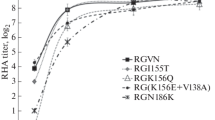Summary
A series of 33 human-avian and human-mammalian influenza virus reassortant clones possessing either HA or both HA and NA genes of the avian or mammalian virus was obtained by crosses of A/USSR/90/77 (H1N1) human virus with 5 avian and 1 mammalian influenza virus strains. All of the reasortants possessing NA genes of the H1N1 human parent virus and HA gene of an avian or mammalian parent virus had high values of infectivity/HA activity ratio. Since this feature could result from a limited virion aggregation, several reassortants were analyzed by velocity sucrose gradient centrifugation. In all cases tested, the reassortants of H3N1, H4N1, H10N1 and H13N1 composition were shown to be aggregated, whereas the preparations of the parent H1N1 virus and the reassortants possessing both HA and NA genes from the avian parents were represented mostly by single virions. The aggregates were formed at 4°C and dissociated at 37°C. The dissociation was blocked by an inhibitor of neuraminidase activity (2-deoxy-2,3-dehydro-N-acetyl-neuraminic acid). The dissociation was reversible since the virions reaggregated at 4°C; however, treatment with bacterial neuraminidase led to an irreversible dissociation of the aggregates. The tendency of the reassortants to aggregate correlates with an increased infectivity/HA ratio. No regular decrease in the neuraminidase activity in the virions of reassortants as compared to the parent H1N1 virus was revealed. The most likely explanation of the observed phenomenon seems to be an inefficient removal of sialic acid residues from the avian virus hemagglutinin by the human virus N1 neuraminidase.
Similar content being viewed by others
References
Breuning A, Scholtissek C (1983) Characterization of cold-sensitive (cs) recombinant between two influenza A strains. Virology 130: 56–64
Breuning A, Scholtissek C (1986) A reassortant between influenza A viruses (H7N2) synthesizing an enzymatically inactive neuraminidase at 40° which is not incorporated into infectious particles. Virology 150: 65–74
Griffin GA, Basak S, Compans RW (1983) Effects of hexose starvation and the role of sialic acid in influenza virus release. Virology 125: 324–334
Kaverin NV, Rudneva IA, Smirnov YA, Finskaya NN (1988) Human-avian influenza virus reassortants: effect of reassortment pattern on multi-cycle reproduction in MDCK cells. Arch Virol 103: 117–126
Kaverin NV, Finskaya NN, Rudneva IA, Gitelman AK, Karitonenkov IG, Smirnov YA (1989) Studies on the genetic basis of human influenza A virus adaptation to mice: degrees of virulence of reassortants with defined genetic content. Arch Virol 105: 29–37
Nakajima K, Sugiura A (1977) Isolation of an influenza virus temperature-sensitive mutant of a new recombination-complementation group. Virology 78: 365–374
Nakajima K, Sugiura A (1977) Three-factor cross of influenza virus. Virology 81: 486–489
Nobusawa E, Aoyama T, Kato H, Suzuki Y, Tateno Y, Nakajima K (1991) Comparison of complete acid sequences and receptor-binding properties among 13 serotypes of hemagglutinins of influenza viruses. Virology 182: 475–485
Palese P, Compans RW (1976) Inhibition of influenza virus replication in tissue culture by 2-deoxy-2,3-dehydro-N-trifluoro-acetyl-neuraminic acid (FANA): mechanism of action. J Gen Virol 33: 159–163
Rigby PW, Dieckmann M, Rhodes C, Berg P (1977) Labeling deoxyribonucleic acid to high specificity in vitro by nick translation with DNA polymerase. J Mol Biol 113: 237–251
Rogers GN, Daniels RS, Skehel JJ, Wiley DC, Wang X-L, Higa HH, Paulson JC (1985) Host-mediated selection of influenza virus receptor variants. J Biol Chem 260: 2362–2367
Schulman JL, Palese P (1976) Selection and identification of influenza virus recombinants of defined genetic composition. J Virol 20: 248–254
Schulman JL, Palese P (1977) Virulence factors of influenza viruses. WSN virus neuraminidase is required for productive infection of MDBK cells. J Virol 24: 170–176
Snyder MH, Buckler-White AJ, London WT, Tierney EL, Murphy BR (1987) The avian influenza virus nucleoprotein gene and a specific constellation of avian and human virus polymerase genes each specify attenuation of avian-human influenza A/Pintail/79 reassortant viruses for monkeys. J Virol 61: 2857–2863
Spear PG, Roizman B (1972) Proteins specified by herpes simplex virus. V. Purification and structural proteins of the herpes virion. J Virol 9: 143–159
Varich NL (1987) The immunosorbtion of influenza virus nucleocapsids from cell lysates as a technique for the studies on viral RNA synthesis. J Virol Methods 16: 115–124
Warren L (1959) The thiobarbituric acid assay of sialic acid. J Biol Chem 234: 1971–1975
Author information
Authors and Affiliations
Rights and permissions
About this article
Cite this article
Rudneva, I.A., Kovaleva, V.P., Varich, N.L. et al. Influenza A virus reassortants with surface glycoprotein genes of the avian parent viruses: effects of HA and NA gene combinations on virus aggregation. Archives of Virology 133, 437–450 (1993). https://doi.org/10.1007/BF01313781
Received:
Accepted:
Issue Date:
DOI: https://doi.org/10.1007/BF01313781




